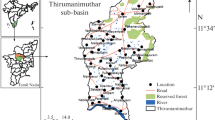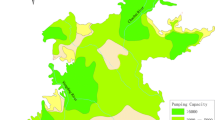Abstract
The sampling data from the groundwater quality monitoring network (GQMN) can not only characterize the properties of the natural resource in groundwater system, but also delineate contaminated area and risk potential by human activities. This study aimed to provide a process for designing GQMN for non-existing monitoring well using Nantou area in Taiwan as the example. First, this study have integrated four contributing factors (land use, soil media, topography and population) of both vulnerability map and hazard map to calculate the Contamination Risk Index (CRI) via Geographic Information System (GIS) model. The results of the map demonstrated that the spatial distribution of the highest contamination risk potential and provided the preliminary deployment of the spatial locations of the candidate monitoring wells. According to the deployment of the candidate monitoring wells, this study used the geostatistical approach to calculate the percentage of the total area with acceptance accuracy of the candidate monitoring wells for different threshold. Based on the defined performance, the available monitoring networks for different threshold of three cases are estimated. The information can support the designer or the decision maker to design appropriate monitoring network whether they have a limited funding or not.






Similar content being viewed by others
Reference
Al-Adamat RAN, Foster IDL, Baban SMJ (2003) Groundwater vulnerability and risk mapping for the basaltic aquifer of the Azraq basin of Jorden using GIS, remote sensing and DRASTIC. Appl Geogr 23:303–324
Andreo B, Goldscheider N, Vadillo I, Vías JM, Neukum C, Sinreich M, Jiménez P, Brechenmacher J, Carrasco F, Hötzl H, Perles MJ, Zwahlen F (2006) Karst groundwater protection: first application of a pan-European approach to vulnerability, hazard and risk mapping in the sierra de L − 016 -. For the monito. Sci Total Environ 357(1–3):54–73
Baalousha B (2010) Assessment of a groundwater quality monitoring network using vulnerability mapping and geostatic: a case study from Heretaunga Plains, New Zealand. Agric Water Manag 97:240–246
Cheng KS, Lin YC, Liou JJ (2008) Rain-gauge network evaluation and augmentation using geostatistics. Hydrol Processes 22:2554–2564
Datta B, Chakrabarty D, Dhar A (2009) Optimal dynamic monitoring network design and identification of unknown groundwater pollution sources. Water Resour Manag 23:2031–2049
Duijvenbooden WV and Waegening HG (1987) Vulnerability of soil and groundwater to pollution, Proceedings/Inf. N.38 of the international Conference, Netherlands, TNO Committee on hydrological research
ESPON Hazards project (2003). The spatial effects and management of natural and technological hazards in general and in relation to climate change. 1st Interim Report, March 2003
Fadlelmawla AA, Fayad M, El-Gamily H, Rashid T, Mukhopadhyay A, Kotwicki A (2011) A land surface zoning approach based on three-component risk criteria for groundwater quality protection. Water Resour Manag 25(6):1677–1697
Glover F (1986) Future paths for integer programming and links to artificial intelligence. Comput Open Resour 13:533–549
Grieve CM, Poss JA, Amrhein C (2006) Response of Matthiola incana to irrigation with salinity wastewaters. Hortscience 41(1):119–123
Jang CS, Liu CW (2004) Geostatistical analysis and conditional simulation for estimating the spatial variability of hydraulic conductivity in the Choushui river alluvial fan. Taiwan Hydrol Processes 18:1333–1350
Jang CS, Liu CW (2005) Contamination potential of nitrogen compounds in the heterogeneous aquifers of the Choushui River alluvial fan, Taiwan. J Contam Hydrol 79:135–155
Kao YH, Liu CW, Jang CS, Zanh SW, Lin KH (2011) Assessment of nitrogen contamination of groundwater in paddy and upland fields. Paddy Water Environ 9:301–307
Ke KY (2013) Application of an integrated surface water-groundwater model to multi-aquifers modeling in Choushui River alluvial fan, Taiwan. Hydrol Process 28:1409–1421
Lin HT, Tan YC, Ke KY, Hsu G, Wu SC (2013) Estimating pumping rates and identifying potential recharge zones for groundwater management in multi-aquifers system. Water Resour Manag 27(9):3293–3306
Liu CW (2004) Decision support systems managing ground water resources the Choushui River alluvial fan in Taiwan. J Am Water Resour Assoc:431–442
Liu CW, Jan CS, Liao CM (2004) Evaluation of arsenic contamination potential using indicator Kriging in the Yun-Lin aquifer (Taiwan). Sci Total Environ 321(1–3):173–188
Nunes LM, Cunha MC, Ribeiro L (2004) Groundwater monitoring network optimization with redundancy reduction. J Water Resour Plan Manag 130:33–43
Rouhani S (1985) Variance reduction analysis. Water Resour Res 21:837–846
Shen Y, Wu Y (2013) Optimization of marine environmental monitoring sites in the Yangtze River estuary and its adjacent sea, China. Ocean Coast Manag 73:92–100
World Health Organisation (WHO). 2004. Guidelines for drinking water quality recommendation .vol. 1, Recommendations, third ed. World Health Organisation Report, Genva
Wu Y (2004) Optimal design of a groundwater monitoring network in Daqing, China. Environ Geol 45:527–535
Wu J, Zheng C, Chien CC (2005) Cost-effective sampling network design for contaminant plume monitoring under general hydrogeological conditions. J Contam Hydrol 77:41–65
Yang CY, Cheng MF, Tsai SS, Hsieh YL (1998) Calcium, magnesium, and nitrate in drinking water and gastric cancer mortality. Jpn J Cancer Res 89:124–130
Acknowledgements
The authors would like to thank the National Science Council of Taiwan for financially supporting this research under contract NSC 103-2625-M-002 -016 -.
Author information
Authors and Affiliations
Corresponding author
Rights and permissions
About this article
Cite this article
Wu, S.C., Ke, KY., Lin, HT. et al. Optimization of Groundwater Quality Monitoring Network Using Risk Assessment and Geostatistic Approach. Water Resour Manage 31, 515–530 (2017). https://doi.org/10.1007/s11269-016-1545-x
Received:
Accepted:
Published:
Issue Date:
DOI: https://doi.org/10.1007/s11269-016-1545-x




